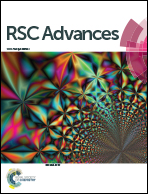Ni3FeN functionalized carbon nanofibers boosting polysulfide conversion for Li–S chemistry†
Abstract
Limiting the shuttle effect of polysulfides is an important means to realizing high energy density lithium–sulfur batteries (Li–S). In this study, an efficient electrocatalyst (CNFs@Ni3FeN) is synthesized by anchoring Ni3FeN in the carbon nanofibers (CNFs). The CNFs@Ni3FeN shows electrocatalytic activity and enhances the conversion of polysulfides. After assembling a battery, a high initial capacity (1452 mA h g−1) and favorable long-time cycling stability (100 cycles) with a capacity retention rate of 83% are obtained by the electrocatalysis of Ni3FeN. Compared with unmodified CNFs, the cycling stability of CNFs@Ni3FeN can be greatly improved. The catalytic mechanism is further deduced by X-ray photoelectron spectroscopy (XPS). Our work will inspire the rational design of CNFs@support hybrids for various electrocatalysis applications.



 Please wait while we load your content...
Please wait while we load your content...